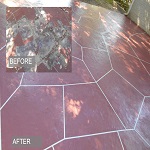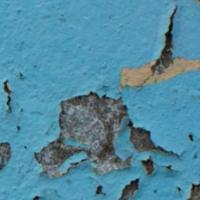DIY: Repairing Concrete Cracks and Chipping
by Decorative Concrete Surfaces on Oct 2, 2018
Concrete surfaces can last a long time but, sooner or later, they may develop signs of damage. The most common issues on concrete are cracks and chipping. If something like these start showing up on your concrete patio, pool deck, or indoor floor, it is important to make the necessary repairs before they get worse. The bigger and worse a crack gets, the more difficult and expensive it is to fix. Repairing damaged concrete can be done by anyone as long as the proper method and tools are used. Here is a brief look at the process of crack and chipping repair.

STEP 1: The Right Material for Repairs
In repairing concrete, you must use a concrete repair mix. This can either be an epoxy compound, a latex patching material, or a mortar mix. Any of these can be used to fill in cracks but for larger ones or those with chipped off areas, mortar mixes are most suitable.
STEP 2: Preparing the Damaged Area
Using a hammer and chisel, gently knock away any loose concrete pieces within the crack or at the edges of the chipped off spot. Then, the chip within the crack to a depth of one inch. Use a wire brush to remove any crumbling pieces within the crack.
STEP 3: Installing the Filler
The process of installing the filter will depend on the type of concrete repair mix you use.
Epoxy or Latex - This is ideal for cracks that are ⅛ inch or smaller. The material is applied using a trowel or putty knife in cracks and chipped areas. Make sure it reaches every nook and cranny in the crack and level it at the same level as the rest of the concrete surface.
Mortar Mix - This is used for larger or wider cracks and chipping. You just have to mix one part of Portland cement and three parts of masonry sand. Water is also added to create a thick paste.
STEP 4: Sealing the Surface
After a concrete repair, it is important that you seal the surface. This will serve as a protective layer against harmful elements. Seal only when the filler material has already dried. This way, you won’t have to worry about sealer issues due to the presence of moisture on the slab.
A DIY for repairing concrete cracks and chipping is possible but not always advisable. Most of the elements involved require skillful preparation and usage. For a more thorough and skilled repair, hire a pro in concrete repairs.
Popular Articles
Three Places to Spend Money on the Exterior of Your Home
When you have the exterior of your home remodeled, you are investing, time, energy and convenience into the project and you want to make sure that...
104845 Views
Homemade Headboards-Make an Upholstered or Wooden Headboard
Homemade headboards can add a lot of personality to any bedroom. They can be coordinated with existing furniture and room decor or they can be the...
80113 Views
When to Use a Brush, Roller or Sponge Brush
Brushes are a good choice for painting trim and woodwork. They are also useful for cutting in the edges around the top and bottom edges and corners...
72773 Views
Creating a Cottage Kitchen with Bead Board
Kitchen decor can range from modern and bold to elegant and elaborate by using strategic kitchen pieces. One of the most popular decorating trends...
58539 Views
Gas Fireplace Diagnostics and Troubleshooting
Follow these steps for diagnosing and troubleshooting Gas Fireplaces repairs. For the average DIYer, this may seem intimidating, depending on the...
35578 Views
Latest Articles
How Much Does it Cost to Take a Bath?
Plumbers know that a bath may seem like a relaxing luxury, but the real cost extends far beyond your water bill. The average soak uses 35 to 50...
on Apr 8, 2025
10 Concrete Patio Ideas on a Budget
A concrete patio can be a game-changer for your outdoor space. It is durable, versatile, and can be customized to fit your style. But what if you...
on Mar 25, 2025
Tips for Creating a Stunning Personalized Photo on Canvas
Order the unique beauty of a personalized photo on canvas and bring your memories to life. With a customized photo on canvas, you can transform...
on Mar 7, 2025
Best Areas to Buy Property in Singapore for Long-Term Growth
Singapore's real estate market remains one of the most stable and lucrative in the world. With limited land supply, strong governmental...
on Feb 18, 2025
Troubleshooting Excess Water in Your HVAC Secondary Condensate Drain Pan
When maintaining your air conditioning system, it is easy to overlook the condensate drain pan - until excess water starts pooling in places where...
on Jan 12, 2025
Featured Articles
What Type of Licensed Contractor Should You Hire?
on Feb 28, 2017
Hire Contractors / Estimates

Looking for a specialty project? There are many types of contractors available for your home improvement needs. Finding the right type of...
Sponsored Articles
Best Areas to Buy Property in Singapore for Long-Term Growth
on Feb 18, 2025
Real Estate / Finance

Singapore's real estate market remains one of the most stable and lucrative in the world. With limited land supply, strong governmental...
Actions
Top Categories
- Garden / Landscaping / Patio — 264
- Kitchen / Bathrooms — 240
- Real Estate / Finance — 203
- Appliance / Repair — 186
- Interior Design / Decor — 184
- HVAC / Air Conditioning — 148
- Cleaning / Maintenance — 144
- Improvements / Remodeling — 131
- Plumbing / Basements — 118
- Floors / Tile / Hardwood — 116
- Doors / Garages — 113
- Safety / Security — 113
Articles Archive
More DIY Articles
Mistakes too Many Make when Hiring Plumbers
Nowadays, it is so much easier to find and hire a plumber than it used to be some time ago because of the fact that the internet easily helps us to...
Top Most Uses of Galvanized Steel
Galvanization is the process by which steel is treated with a rust-resistant zinc coating. Galvanized steel is usually manufactured by a technique...
Why Replacing You Vacuum Cleaner is Better than Repairing the Old One
Considering the hectic lifestyles and urge for swift solutions these days, one of the most important devices all homes need is a handy and reliable...
Quick Tips to Sell Your Home Faster
Selling a house is never easy. Some people imagine that you simply put the house up on the market and it's sold the next day. Well, unfortunately,...
Go for a Green Garage
When considering a new garage, many aspects must be evaluated: cost, material, functionality and even environmental impact. You can check out a few...

